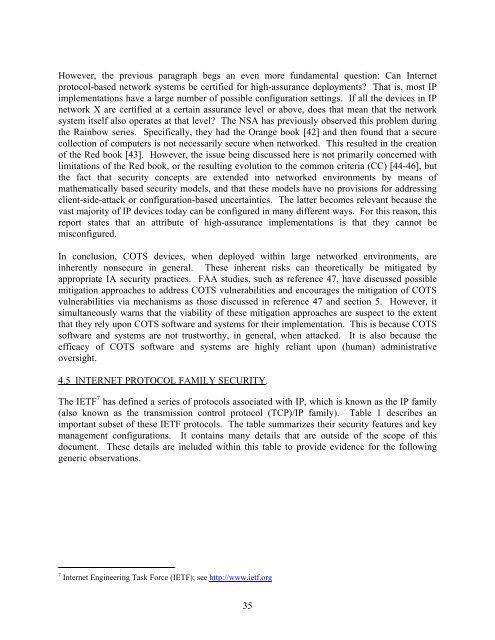Local Area Networks (LANs) in Aircraft - FTP Directory Listing - FAA
Local Area Networks (LANs) in Aircraft - FTP Directory Listing - FAA
Local Area Networks (LANs) in Aircraft - FTP Directory Listing - FAA
You also want an ePaper? Increase the reach of your titles
YUMPU automatically turns print PDFs into web optimized ePapers that Google loves.
However, the previous paragraph begs an even more fundamental question: Can Internet<br />
protocol-based network systems be certified for high-assurance deployments? That is, most IP<br />
implementations have a large number of possible configuration sett<strong>in</strong>gs. If all the devices <strong>in</strong> IP<br />
network X are certified at a certa<strong>in</strong> assurance level or above, does that mean that the network<br />
system itself also operates at that level? The NSA has previously observed this problem dur<strong>in</strong>g<br />
the Ra<strong>in</strong>bow series. Specifically, they had the Orange book [42] and then found that a secure<br />
collection of computers is not necessarily secure when networked. This resulted <strong>in</strong> the creation<br />
of the Red book [43]. However, the issue be<strong>in</strong>g discussed here is not primarily concerned with<br />
limitations of the Red book, or the result<strong>in</strong>g evolution to the common criteria (CC) [44-46], but<br />
the fact that security concepts are extended <strong>in</strong>to networked environments by means of<br />
mathematically based security models, and that these models have no provisions for address<strong>in</strong>g<br />
client-side-attack or configuration-based uncerta<strong>in</strong>ties. The latter becomes relevant because the<br />
vast majority of IP devices today can be configured <strong>in</strong> many different ways. For this reason, this<br />
report states that an attribute of high-assurance implementations is that they cannot be<br />
misconfigured.<br />
In conclusion, COTS devices, when deployed with<strong>in</strong> large networked environments, are<br />
<strong>in</strong>herently nonsecure <strong>in</strong> general. These <strong>in</strong>herent risks can theoretically be mitigated by<br />
appropriate IA security practices. <strong>FAA</strong> studies, such as reference 47, have discussed possible<br />
mitigation approaches to address COTS vulnerabilities and encourages the mitigation of COTS<br />
vulnerabilities via mechanisms as those discussed <strong>in</strong> reference 47 and section 5. However, it<br />
simultaneously warns that the viability of these mitigation approaches are suspect to the extent<br />
that they rely upon COTS software and systems for their implementation. This is because COTS<br />
software and systems are not trustworthy, <strong>in</strong> general, when attacked. It is also because the<br />
efficacy of COTS software and systems are highly reliant upon (human) adm<strong>in</strong>istrative<br />
oversight.<br />
4.5 INTERNET PROTOCOL FAMILY SECURITY.<br />
The IETF 7 has def<strong>in</strong>ed a series of protocols associated with IP, which is known as the IP family<br />
(also known as the transmission control protocol (TCP)/IP family). Table 1 describes an<br />
important subset of these IETF protocols. The table summarizes their security features and key<br />
management configurations. It conta<strong>in</strong>s many details that are outside of the scope of this<br />
document. These details are <strong>in</strong>cluded with<strong>in</strong> this table to provide evidence for the follow<strong>in</strong>g<br />
generic observations.<br />
7 Internet Eng<strong>in</strong>eer<strong>in</strong>g Task Force (IETF); see http://www.ietf.org<br />
35
















